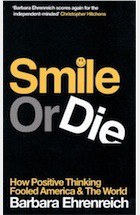In Smile Or Die, author Barbara Ehrenreich documents her personal agonizing encounter with an ideological force –one that she asserts encourages us to deny reality and submit cheerfully to misfortune, and blame only ourselves for our fate.
After a routine mammogram picked up her cancer cells, Ehrenreich promptly discovered the dearth of choices when it came to the management of the dreaded disease. Her diagnosis duly documented, she was on the predictable and well - trodden treadmill; one that would lead to a mutilating mastectomy or to a simple lumpectomy, inevitably followed by radiation or chemotherapy.
As her breast cancer career progressed, to her utmost surprise, Ehrenreich found that many women did not view the disease with the horror and dread that supposedly accompanies the malady. Instead the attitude towards the deadly affliction was upbeat and even eagerly acquisitive. Ehrenreich documents the fact that there are between 2 and 3 million American women in various stages of breast cancer treatment making up a market for all things breast cancer: pink breast cancer t- shirts, assortments of pyjamas, lingerie, scarves, caps and numerous commodities that brighten the patient's home including cuddly teddy bears, candles, coffee mugs, and the list goes on.
In Smile Or Die, this approach to the disease is described as an ultra feminine theme of breast cancer…an infantilizing trope with Ehrenreich asserting that she doubt that men with prostate cancer would receive matchbox cars. As her quest for information about the disease, its course and treatments progressed, her isolation grew - for few sufferers shared her sense of outrage over the disease itself, its causation and its pitiful ways of addressing the progress.
Her rage focussed on the lack of attention given to the causes of the now decades old breast cancer epidemic. There were a number of factors thought to be involved such as overly-processed diets, modern lifestyles, genetic factors and toxic environments, just to name a few. The author of Smile Or Die, asserts that amongst the breast cancer community there is scant attention given, nor enough anger expressed, over the painful and inadequate treatments that form the bulk of available therapies. In the place of justified anger there is countless pity and passivity: the victim becomes a survivor and those who die become our lost sisters.
Ehrenreich describes the cheerfulness of the breast cancer culture and how there those in the community who regard the disease as a gift, a rite of passage. As a breast cancer patient, Ehrenreich was encouraged to think positively and embrace cancer with a smile. Her analysis of such sugar-coating is that this comes at a great cost which is the denial of one's true feelings of fear and anger.
This author’s anger is with the cancer industry along with the medical and pharmaceutical institutions for her breast cancer was iatrogenic - she had been taking HRT or hormone replacement therapy for just under 8 years. The Women’s Health Initiative trial in 2002 found that the popular hormone therapy caused increases in the cases of breast cancer and in 2008, The Medical Journal of Australia, reported that the reduction in breast cancer among women over 50 years is mostly due to the decrease in the use of HRT, the drug which was given to post menopausal women for relief of hot flushes and to ensure they stayed forever young.
Smile Or Die by Barbara Ehrenreich will stimulate the public conversation that has not taken place – what causes the disease and why there is such a lack of outrage amongst breast cancer sufferers and the community itself. Where is the anger?
Barbara Ehrenreich is the author of many books including Nickle and Dimmed and Global women: nannies, maids and sex workers.

